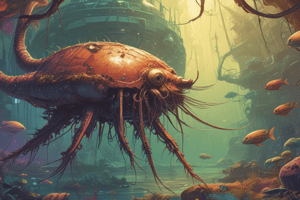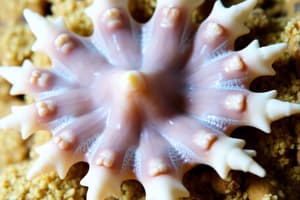Podcast
Questions and Answers
What type of body symmetry do echinoderms exhibit as adults?
What type of body symmetry do echinoderms exhibit as adults?
- Radial symmetry (correct)
- Bilateral symmetry
- Pentamerous symmetry
- Asymmetrical
Which of the following systems is absent in echinoderms?
Which of the following systems is absent in echinoderms?
- Digestive system
- Nervous system
- Reproductive system
- Circulatory system (correct)
How do echinoderms typically exchange gases?
How do echinoderms typically exchange gases?
- Skin gills and diffusion (correct)
- Through respiratory sacs
- Blood vessels
- Through specialized gills
What is a characteristic feature of echinoderm reproduction?
What is a characteristic feature of echinoderm reproduction?
What role does the madreporite play in echinoderms?
What role does the madreporite play in echinoderms?
Which structure allows echinoderms to move and capture food?
Which structure allows echinoderms to move and capture food?
In echinoderms, which of the following structures is involved in sensory perception?
In echinoderms, which of the following structures is involved in sensory perception?
How do some echinoderms regenerate lost body parts?
How do some echinoderms regenerate lost body parts?
What is one of the primary functions of spines in echinoderms?
What is one of the primary functions of spines in echinoderms?
Which echinoderm class does NOT have spines?
Which echinoderm class does NOT have spines?
What protective mechanism do some echinoderms use against predators?
What protective mechanism do some echinoderms use against predators?
What type of feeding method do sand dollars use?
What type of feeding method do sand dollars use?
Which echinoderm is known for causing damage to coral reefs?
Which echinoderm is known for causing damage to coral reefs?
What is the main reason echinoderms have few predators?
What is the main reason echinoderms have few predators?
Which of the following echinoderms is a known predator?
Which of the following echinoderms is a known predator?
What is the role of papulae in echinoderms?
What is the role of papulae in echinoderms?
What is the primary function of the muscular ampula in tube feet?
What is the primary function of the muscular ampula in tube feet?
Which appendage type is responsible for locomotion in echinoderms?
Which appendage type is responsible for locomotion in echinoderms?
What feature distinguishes the pedicellariae of urchins from those of asteroids?
What feature distinguishes the pedicellariae of urchins from those of asteroids?
How do pedicellariae contribute to the defense mechanisms of echinoderms?
How do pedicellariae contribute to the defense mechanisms of echinoderms?
Which type of pedicellariae is characterized by having teeth on the blades?
Which type of pedicellariae is characterized by having teeth on the blades?
What is the primary habitat of Echinodermata?
What is the primary habitat of Echinodermata?
What is the function of the ampulla within the tube foot's operation?
What is the function of the ampulla within the tube foot's operation?
Which characteristic is unique to Echinodermata?
Which characteristic is unique to Echinodermata?
What type of symmetry do adult echinoderms exhibit?
What type of symmetry do adult echinoderms exhibit?
Where are tube feet typically located on an echinoderm's body?
Where are tube feet typically located on an echinoderm's body?
What is the role of the water-vascular system in echinoderms?
What is the role of the water-vascular system in echinoderms?
What is a common misconception about the primary function of tube feet?
What is a common misconception about the primary function of tube feet?
How are the calcareous ossicles arranged in different echinoderm species?
How are the calcareous ossicles arranged in different echinoderm species?
What is the significance of the absence of a head or brain in echinoderms?
What is the significance of the absence of a head or brain in echinoderms?
In which environment do echinoderms typically have a higher population density?
In which environment do echinoderms typically have a higher population density?
What is the maximum depth at which deep-water echinoderms can be found?
What is the maximum depth at which deep-water echinoderms can be found?
Flashcards are hidden until you start studying
Study Notes
Overview of Echinodermata
- Echinodermata translates to "spiny skin" in Greek.
- Comprises approximately 6000 species, exclusively marine.
- Found in all marine environments except the Arctic, typically near shores up to 100 meters deep, while some inhabit depths of 1000 to 5000 meters.
- Greater abundance in warmer waters.
Habitat and Behavior
- Echinoderms often remain concealed during the day and primarily feed at night.
- Adaptable to a wide temperature range; distribution influenced by temperature.
- Historically present in large numbers, as supported by fossil records, with food availability being a significant attraction.
Key Features
- Body structure is non-metameric with adult forms exhibiting radial, pentamerous symmetry.
- Body divided into oral and aboral surfaces; lacks a centralized head or brain.
- Composed of calcareous ossicles that form a flexible endoskeleton, covered by epidermis.
Unique Characteristics
- Presence of a water vascular system facilitating locomotion, respiration, and feeding.
- Adults display pentaradial symmetry while larvae exhibit bilateral symmetry.
- No circulatory, excretory, or respiratory systems; gas exchange occurs via skin gills and diffusion through tube feet.
Reproductive Traits
- Echinoderms have separate sexes and possess two gonads in each arm for egg and sperm production.
- External fertilization occurs, with females producing up to 200 million eggs in a season.
- Development involves a larval stage that metamorphoses into an adult after approximately two years.
- Capable of asexual reproduction through arm regeneration.
Water Vascular System
- An internal, closed system utilizing seawater, beginning with a madreporite on the aboral surface.
- Water flows through a series of canals, including the stone canal and ring canal, down to radial canals in each arm.
- Tube feet, connected to this system, facilitate movement, feeding, and attachment.
Tube Feet and Appendages
- Tubular projections with sucker-like tips, located on the ambulacral areas for functionality in locomotion, feeding, and respiration.
- Four types of body wall appendages: tube feet, spines, pedicellariae, and papulae.
Pedicellariae
- Pincer-like structures found primarily on surface of asteroids and echinoids, absent in ophiuroids and holothurians.
- Functions include deterring larval settlement and defense against predators through pinching actions.
Feeding Strategies
- Echinoderms exhibit diverse feeding habits: some are predators (e.g., starfish), while others are detritivores or grazers (e.g., sea urchins).
- Noted for causing significant ecological damage, such as predation on oysters and coral reefs.
Protection Mechanisms
- Utilize spiny exoskeletons and sometimes venomous defenses to deter predation.
- Chemical secretions can ensnare predators, and toxins like holothurin can poison fish.
Ecological Role and Importance
- Echinoderms contribute significantly to marine ecosystems; some species serve as food sources in various cultures.
- Toxins produced by certain echinoderms can impact fish populations, influencing ecological dynamics.
- Widely used for research due to the accessibility of gametes for developmental biology studies.
Classification
- Phylum Echinodermata is classified into five classes:
- Crinoidea: Sea lilies and feather stars.
- Asteriodea: Starfish.
- Ophiuroidea: Basket stars and brittle stars.
- Echinoidea: Sea urchins and sand dollars.
- Holothuroidea: Sea cucumbers.
Studying That Suits You
Use AI to generate personalized quizzes and flashcards to suit your learning preferences.




